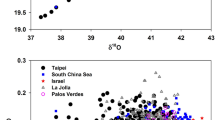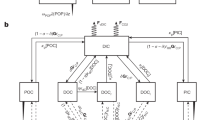Abstract
Carbon uptake by the oceans and by the terrestrial biosphere can be partitioned using changes in the 12C/13C isotopic ratio (δ13C) of atmospheric carbon dioxide1,2,3,4, because terrestrial photosynthesis strongly discriminates against 13CO2, whereas ocean uptake does not. This approach depends on accurate estimates of the carbon isotopic discrimination of terrestrial photosynthesis (Δ; ref. 5) at large regional scales6, yet terrestrial ecosystem heterogeneity7 makes such estimates problematic. Here we show that ablated plant wax compounds in continental air masses can be used to estimate Δ over large spatial scales and at less than monthly temporal resolution. We measured plant waxes in continental air masses advected to Bermuda, which are mainly of North American origin, and used the wax isotopic composition to estimate Δ simply. Our estimates indicate a large (5–6‰) seasonal variation in Δ of the temperate North American biosphere, with maximum discrimination occurring in late spring, coincident with the onset of production. We suggest that the observed seasonality arises from several factors, including seasonal shifts in the proportions of production by C3 and C4 plants, and environmentally controlled adjustments in the photosynthetic discrimination of C3-plant-dominated ecosystems.
This is a preview of subscription content, access via your institution
Access options
Subscribe to this journal
Receive 51 print issues and online access
$199.00 per year
only $3.90 per issue
Buy this article
- Purchase on Springer Link
- Instant access to full article PDF
Prices may be subject to local taxes which are calculated during checkout



Similar content being viewed by others
References
Tans, P. P., Berry, J. A. & Keeling, R. F. Oceanic 13C/12C observations: a new window on oceanic CO2 uptake. Global Biogeochem. Cycles 7, 353–368 (1993)
Ciais, P. et al. Partitioning of ocean and land uptake of CO2 as inferred by δ13C measurements from the NOAA Climate Modeling and Diagnostics Laboratory global air sampling network. J. Geophys. Res. 100, 5051–5070 (1995)
Francey, R. J. et al. Changes in oceanic and terrestrial carbon uptake since 1982. Nature 373, 326–330 (1995)
Rayner, P. J., Enting, I. G., Francey, R. J. & Langefields, R. Reconstructing the recent carbon cycle from atmospheric CO2, δ13C and O2/N2 observations. Tellus 51B, 213–232 (1999)
Farquhar, G. D. & Lloyd, J. in Stable Isotopes and Plant Carbon–Water Relations (eds Ehleringer, J. R., Hall, A. H. & Farquhar, G. D.) 47–70 (Academic, San Diego, 1993)
Fung, I. et al. Carbon 13 exchanges between the atmosphere and biosphere. Global Biogeochem. Cycles 11, 507–533 (1997)
Ehleringer, J. R., Hall, A. E. & Farquhar, G. D. (eds) Stable Isotopes and Plant Carbon–Water Relations (Academic, San Diego, 1993)
Flanagan, L. B. & Ehleringer, J. R. Ecosystem–atmosphere CO2 exchange: interpreting signals of change using stable isotopic ratios. Trends Ecol. Evol. 13, 10–14 (1998)
Marshall, J. D. & Zhang, J. Carbon isotope discrimination and water use efficiency in native plants of the north central Rockies. Ecology 75, 1887–1895 (1994)
Ehleringer, J. R. Variation in leaf carbon isotope discrimination in Encelia farinosa: implications for growth, competition, and drought survival. Oecologia 95, 340–346 (1993)
Smedley, M. P. et al. Seasonal carbon isotopic discrimination in a grassland community. Oecologia 85, 314–320 (1991)
Korner, Ch., Farquhar, G. D. & Wang, S. C. Carbon isotopic discrimination by plants follows latitudinal and altitudinal trends. Oecologia 88, 30–40 (1991)
Lloyd, J. & Farquhar, G. D. δ13C discrimination during CO2 assimilation by the terrestrial biosphere. Oecologia 99, 201–215 (1994)
Bakwin, P. S., Tans, P. P., White, J. W. C. & Andes, R. J. Determination of the isotopic 13C/12C discrimination by terrestrial biology from a global network of observations. Global Biogeochem. Cycles 12, 555–562 (1998)
Gulz, P.-G. Epicuticular leaf waxes in the evolution of the plant kingdom. J. Plant Physiol. 143, 453–464 (1994)
Lockheart, M. J., Van Bergen, P. F. & Evershed, R. P. Variations in the stable isotopic compositions of individual lipids from the leaves of higher angiosperms: implications for the study of higher plant-derived sedimentary organic matter. Org. Geochem. 26, 137–153 (1997)
Rogge, W. F., Hildemann, L. M., Mazurek, M. A., Cass, G. R. & Simoneit, B. R. T. Sources of fine organic aerosol 4, Particles shed from leaf surface of higher plants. Environ. Sci. Technol. 28, 1375–1388 (1993)
Hadley, J. L. & Smith, W. K. Wind erosion of leaf surface wax in alpine timeberline conifers. Arctic Alpine Res. 21, 392–398 (1989)
Peltzer, E. T. & Gagosian, R. B. in Chemical Oceanography (eds Riley, J. P., Chester, R. & Duce, R. A.) Vol. 10 282–338 (Academic, San Diego, 1989)
Simoneit, B. R. T. Organic matter of the troposphere—V: Application of molecular marker analysis to biogenic emissions into the troposphere for source reconciliations. J. Atmos. Chem. 8, 251–275 (1989)
Conte, M. H., Weber, J. C., Flanagan, L. P. & Carlson, P. Groundtruthing the CSIA-aerosol technique for estimation of carbon isotopic discrimination of terrestrial photosynthesis. EOS Trans. AGU 82(20), S77 (2001)
Zafiriou, O. C., Gagosian, R. B., Peltzer, E. T. & Almond, J. B. Air-to-sea fluxes of lipids at Enewetak Atoll. J. Geophys. Res. 90, 2409–2423 (1985)
Moody, J. L., Oltsman, S. J., Levy, H. & Merrill, J. T. Transport climatology of tropospheric ozone: Bermuda, 1988–1991. J. Geophys. Res. 100, 7179–7194 (1995)
Conte, M. H. & Weber, J. C. Long range atmospheric transport of terrestrial organic biomarkers to the western North Atlantic. Org. Geochem. Special issue Advances in Organic Geochemistry 2001 (in the press)
Collister, J. W., Rieley, G., Stern, B., Eglinton, G. & Fry, B. Compound specific isotopic 13C analyses of leaf lipids from plants with differing carbon dioxide metabolism. Org. Geochem. 21, 619–628 (1994)
Ballentine, D. C., Macko, S. A. & Turekian, V. C. Variability of stable carbon isotopic compositions in individual fatty acids from combustion of C4 and C3 plants: implications for biomass burning. Org. Geochem. 25, 97–104 (1998)
Kawamura, K. in Biogeochemical Processes and Ocean Flux in the Western Pacific (eds Sakai, H. & Nozaki, Y.) 31–51 (Terra Science, Tokyo, 1995)
Randerson, J. T., Thompson, M. V., Conway, T. J., Fung, I. Y. & Field, C. The contribution of terrestrial sources and sinks to trends in the seasonal cycle of atmospheric carbon dioxide. Global Biogeochem. Cycles 11, 535–560 (1997)
Ehleringer, J. R., Cerling, T. E. & Helliker, B. R. C4 photosynthesis, atmospheric CO2, and climate. Oecologia 112, 285–299 (1997)
Still, C. J., Berry, J. A., Carbo, M. R., Fu, W. & Verma, S. B. Seasonal changes in photosynthesis and respiration from a mixed C3–C4 tallgrass prairie. EOS Trans. AGU 80, F93 (1999)
Acknowledgements
We thank AEROCE investigators J. Prospero, H. Maring, J. Merrill and M. McKay for assistance with sampling and sharing unpublished data; C. Johnson and L. Houghton for mass spectrometric analyses; and J. Randerson for sharing CASA model data. L. Flanagan, J. Farrington, J. Hayes, J. Fessenden and J. Randerson provided comments and suggestions that greatly improved the paper.
Author information
Authors and Affiliations
Corresponding author
Ethics declarations
Competing interests
The authors declare that they have no competing financial interests.
Rights and permissions
About this article
Cite this article
Conte, M., Weber, J. Plant biomarkers in aerosols record isotopic discrimination of terrestrial photosynthesis. Nature 417, 639–641 (2002). https://doi.org/10.1038/nature00777
Received:
Accepted:
Issue Date:
DOI: https://doi.org/10.1038/nature00777
This article is cited by
-
Ecological stability of Late Pleistocene-to-Holocene Lesotho, southern Africa, facilitated human upland habitation
Communications Earth & Environment (2023)
-
Spatiotemporal distribution and source variations of hydrocarbons in surface sediments from the Pearl River Estuary, Southern China
Journal of Soils and Sediments (2021)
-
Molecular distributions and compound-specific stable carbon isotopic compositions of lipids in wintertime aerosols from Beijing
Scientific Reports (2016)
-
Characterstics of seasonal variations of leaf n-alkanes and n-alkenes in modern higher plants in Qingjiang, Hubei Province, China
Science Bulletin (2008)
-
Compound-specific carbon isotope compositions of individual long-chain n-alkanes in severe Asian dust episodes in the North China coast in 2002
Chinese Science Bulletin (2006)
Comments
By submitting a comment you agree to abide by our Terms and Community Guidelines. If you find something abusive or that does not comply with our terms or guidelines please flag it as inappropriate.



